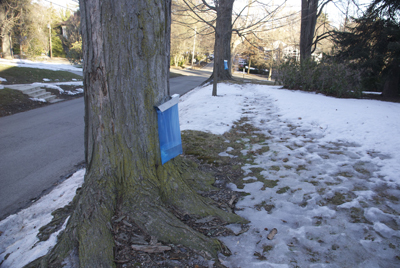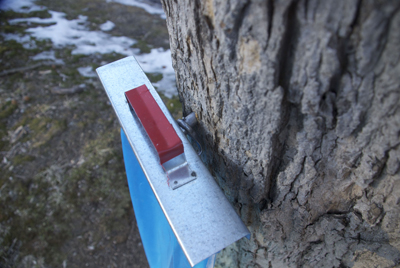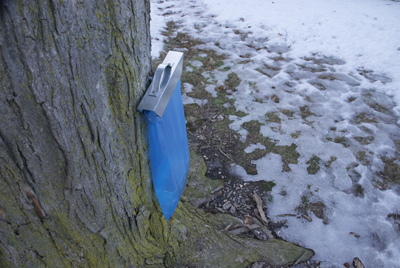Tap a Maple

By Isabell Newlin, Good Food student worker
Elm Street, which runs by the President’s house and the Good Food Garden, is lined with sugar maples. If you have walked down this street in the past few weeks, you might have noticed a couple of blue bags hanging from the trunks. This winter a few of us (Swarthmore students) tapped three of these maples, and we have been boiling the sap down to make syrup.

Equipment used to collection the sap. photo credit: B. Dair
To tap a maple you need a drill (7/16 in), a spout, a mallet, and a bucket. As the days get warmer and temperatures rise above freezing, the difference between day and night generates pressure in the roots of the maples and their sap runs up from the roots into the trunk and branches.
Drill a hole about two inches into the tree and tap the spout into it with your mallet. Angle the drill upwards at a very slight angle so that gravity will draw the sap down into your bucket. At the end of the spout is a hole, to catch the sap is coming upwards from the roots. There is a hook on the spout on which to hang a bucket, or bright blue bag. In the Delaware Valley, the sap often starts running at the beginning of February, when it first gets up to 40 degrees F.
The amount of sap we get each day varies a great deal. When it is warm, more than a gallon; when it is below freezing, very little. Sugar maples, Acer saccharum, have the highest concentration of sugar in their sap, but you can make syrup out of the sap from silver maples, Acer saccharinum, and black maples, Acer nigrum, too.

Blue bags used to collect sap. photo credit: B. Dair
We have collected about 20 gallons of sap over the past two weeks, which as syrup is very roughly 1/30th its original volume.





Shanon Baas
Posted at 21:48h, 02 JuneMaple syrup is a syrup usually made from the xylem sap of sugar maple, red maple, or black maple trees, although it can also be made from other maple species. In cold climates, these trees store starch in their trunks and roots before the winter; the starch is then converted to sugar that rises in the sap in the spring. Maple trees can be tapped by boring holes into their trunks and collecting the exuded sap. The sap is processed by heating to evaporate much of the water, leaving the concentrated syrup.:*-^
Most up-to-date write-up straight from our new blog
<http://ideascollection.org/